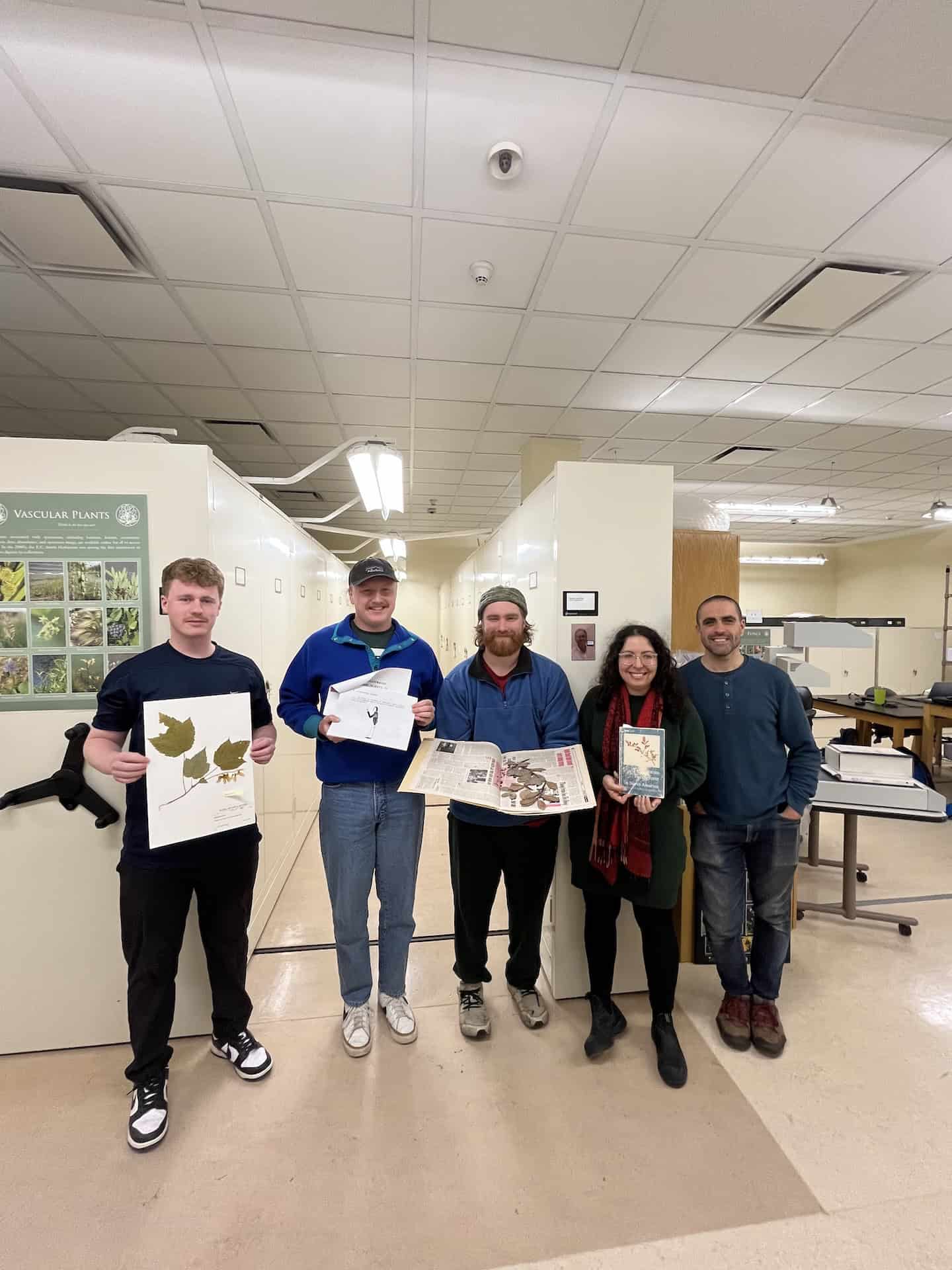
Recently there was cause for celebration in the E.C. Smith Herbarium, part of the Irving Biodiversity Collection at Acadia University. Thanks to the dedication of researchers in Dr. Zoë Migicovsky’s lab (Biology) nearly 7000 backlogged herbarium specimens have been inventoried for integration into the Herbarium proper and will eventually be made available through digitization for researchers globally.
This sizeable collection is affectionately known as “Sam’s Blueberries”. The late Dr. Sam van der Kloet was a professor of Biology, botanist, and past curator of the E.C. Smith Herbarium. Sam was renowned as the world’s leading expert in the taxonomy and ecology of Vaccinium species, which are most famous for blueberries and cranberries. Regrettably, Dr. van der Kloet passed unexpectedly in 2011, leaving his world-class collection unprocessed. His collection encompasses a lifetime of work with his specimens collected from 1973 to 2011; which include samples from at least 28 countries.
Reaching this milestone has been possible thanks to a large team. Seven student and staff researchers have contributed approximately 800 hours to processing the backlog. While the task initially seemed insurmountable, through collective action and determination, their progress quickly snowballed into momentum that would take them nearly a year and a half of part-time work to complete the inventory.
Processing Highlights
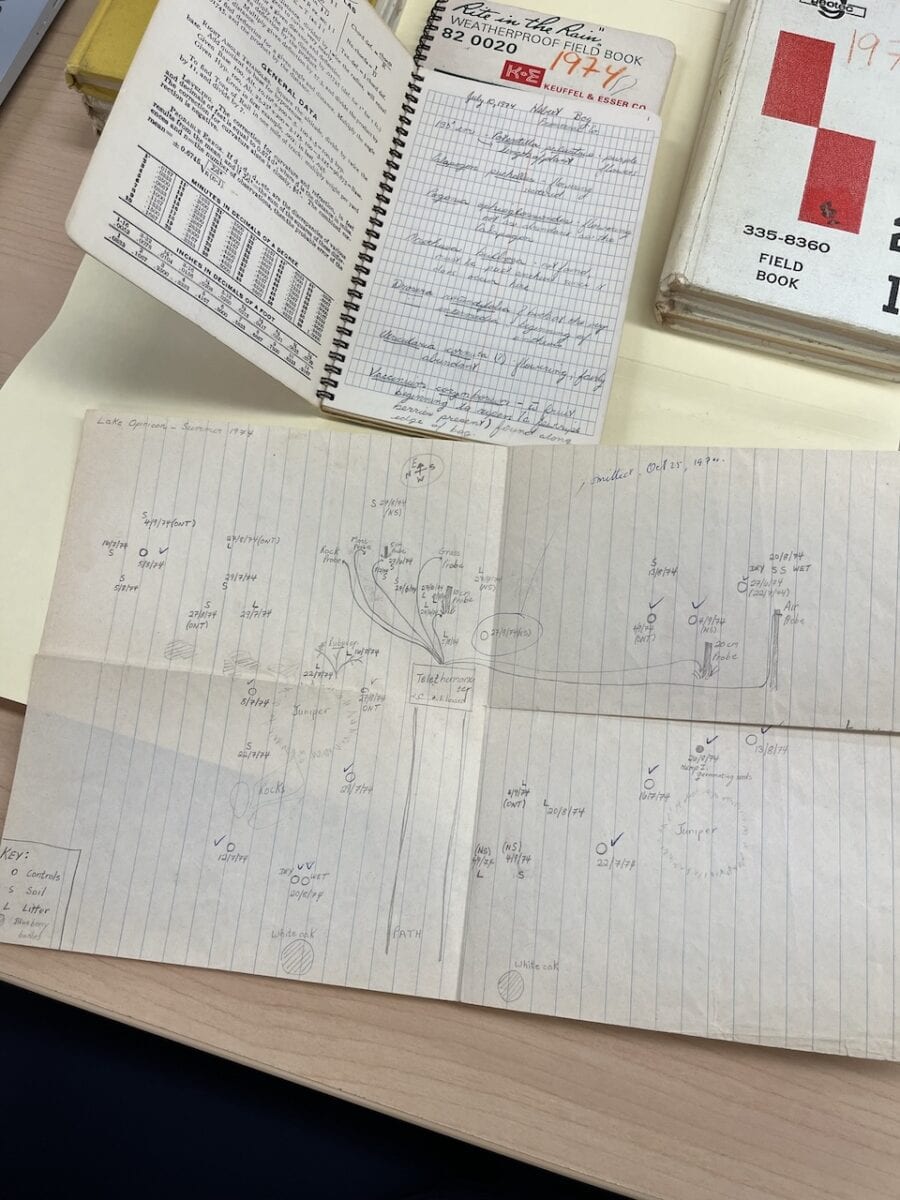
Researchers ventured to the Acadia Archives to cross reference specimen locations with Sam’s field notebooks. Many of the specimens had partial information and it turned into some detective work to build complete descriptions for the plant specimens. A herbarium specimen label should have a species identity, date, location, habitat description- and today GPS coordinates. Notably, collecting specimens was a family affair, many of Sam’s field notes were curated by his late wife Carol van der Kloet, and his children often accompanied him in his field work.
“Seeing all of his notes, books, photographs and draft manuscripts was both impressive and overwhelming. But it gave a lot of context to what we were seeing in the Herbarium”, said Terrell Roulston, research associate in Dr. Migicovsky’s lab.
While in the Herbarium “accessions” refer to the specimens, in the Archives “accessions” refer to his fonds which were donated by Carol, herself a librarian and archivist, after his passing. These accessions are the only ones deposited in the Archives from a professor of Biology at Acadia.
Sam’s collection in the Herbarium contains plant specimens from around the world, with a focus on the diversity in North America. However, Sam’s reputation as a plant taxonomist led to him being invited on collection trips in many countries, as well as the far north of Canada in the Arctic. A highlight of the collection is a holotype of Vaccinium hiepii van der Kloet, which is the first, individual specimen that was used to describe a species. The specimen of Vaccinium hiepii was collected by Sam in northern Vietnam in 1997 and was recently requested by researchers in Vietnam to help describe new species of Vaccinium in that region. Thanks to the efforts of those processing the backlog this information was able to be shared, where it would have been previously inhibited.
Terrell had this to say about processing Sam’s collection “As Sam traveled and collected specimens, he would press and store them using local newspapers or flyers. As we went through his collection it was like going through a time capsule, where we could read different headlines from the past, or compare prices of groceries to those of today (which was disheartening). And it was especially cool seeing newspapers from foreign countries, such as Vietnam or Papua New Guinea. It’s symbolic, taxonomy just like newspapers is a dying art”.
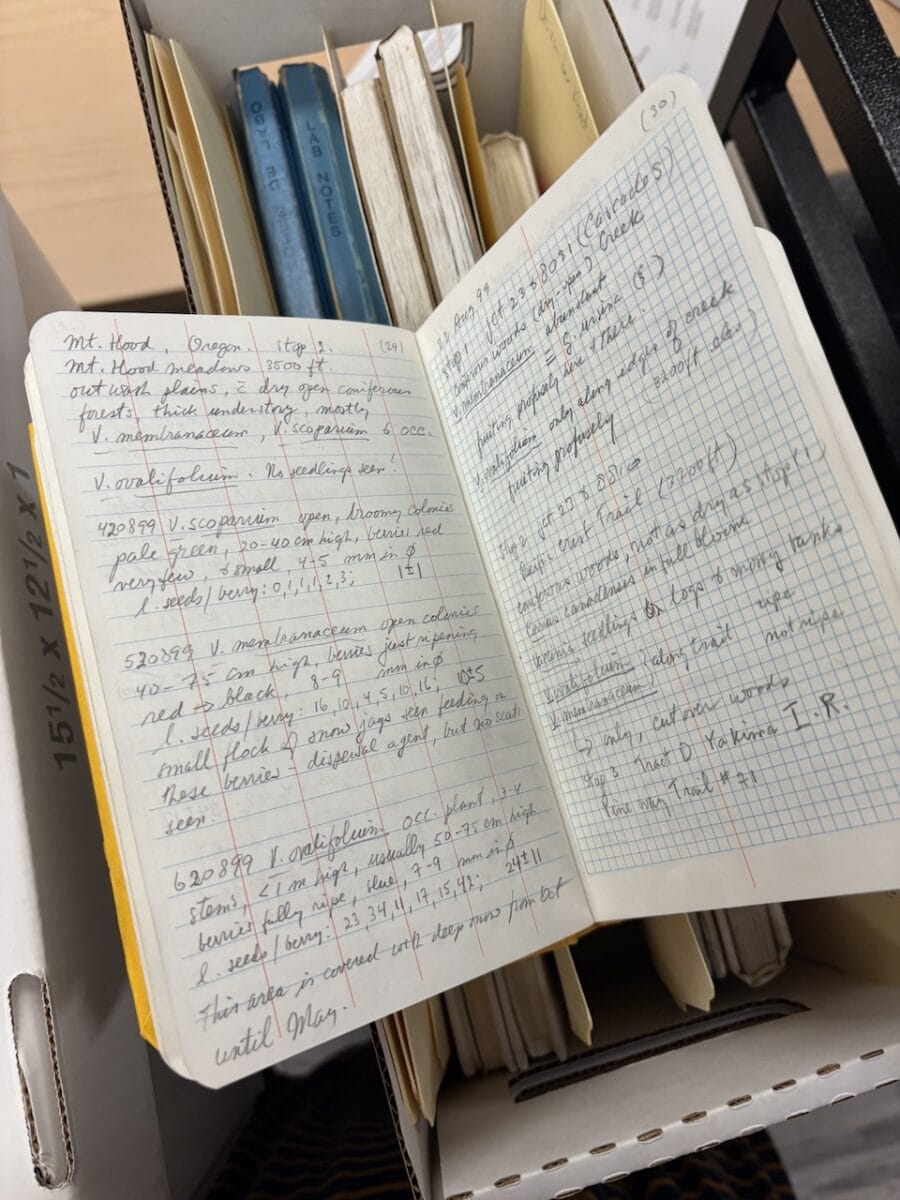
One of the largest hurdles to processing this backlog was that Sam and Carol’s handwriting was cursive, which the Gen Z researchers are removed from. While they found their cursive skills from elementary school returned to them somewhat, in proper new school fashion they also leveraged AI to help decipher the text. These handwritten notes written in the margins of newspapers were the most useful source of information for completing the inventory.
Looking Forward
Dr. Migicovsky originally became interested in Sam’s collection when producing range maps of Lowbush Blueberry, or Vaccinium augustifolium Ait. She realized there were many more potential data points stored in the herbarium that weren’t accessible for research, these are termed “ghost data”. Dr. Migicovsky also has a personal connection to the collection. Although Dr. van der Kloet was retired during her time as an Acadia Biology student, he remained on campus as the University Botanist and her honours research, supervised by Dr. Rodger Evans (former director of the E.C. Smith Herbarium), included working with some of Dr. van der Kloet’s Vaccinium.
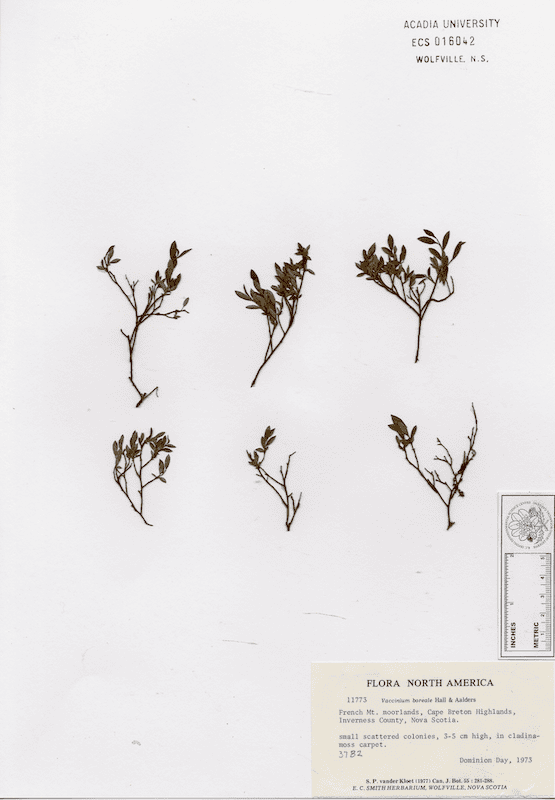
Dr. Migicovsky shared, “It was a full circle moment to return to Acadia and one of the first things on my radar for my research lab, which studies perennial fruit crops and their wild relatives, was Sam’s blueberries. Now that we have completed the initial inventory, I am excited for future research that makes use of the collection. For example, one of our future projects will be to examine plant morphology in Vaccinium across the broad taxonomic range—over 100 different species—included in the collection.”
Pictured is a sample specimen of Vaccinium boreal HA. collected by Sam in 1973.
A processing dilemma ensued. Alain Belliveau, Herbarium Manager explained “Sam’s collection is significant, it occupies an entire row of tall cabinets in the E.C. Smith Herbarium. We discussed merits of keeping the collection separate, versus the work of fully integrating thousands of specimens into already full, and alphabetized sub cabinets. It is rare to keep a collection within a herbarium separate, but it does speak to the importance and size of his collection that we are considering this option. This collection is among the top three largest from a single collector in the history of the E.C. Smith Herbarium. The size is only rivaled by the late Dr. Ken Harrison Sr., and the late E.C. Smith, after whom the herbarium was named”.
Next steps for Sam’s collections will likely be to fully integrate a large portion of it into the E.C. Smith Herbarium, ship some specimens to other institutions around the world, and complete identification and curation work for many others. All three streams of work will eventually result in the online publication of Sam’s contributions into the Global Biodiversity Information Facility (GBIF) and Canadensys, making them openly accessible globally and giving the specimens a renewed use honouring his legacy.
When asked how significant Sam’s contributions are, Belliveau responded by saying “Sam’s research and influence was so great that it essentially prompted these recent and monumental efforts to curate and digitize his own collections, long after his passing. His contributions will continue to inspire this kind of progress in the botany world, in the blueberry research world, at Acadia University and beyond among pupils of pupils.”
About the E.C. Smith Herbarium
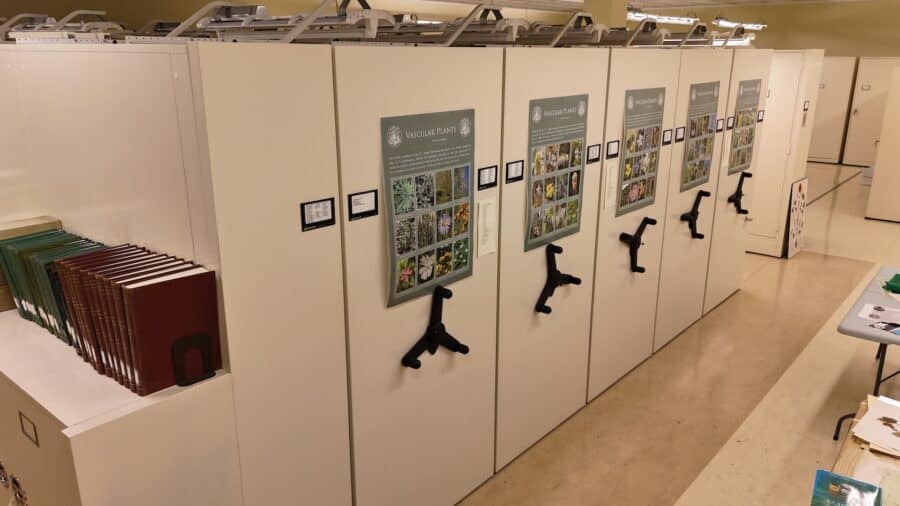
The E.C. Smith Herbarium houses the largest collection of dried plants, bryophytes, fungi and lichens in Atlantic Canada, the collection is over 200 000 specimens. The herbarium moved into the world-class K.C. Irving Environmental Science Centre and became part of the Irving Biodiversity Collection in 2002, along with the Harriet Irving Botanical Gardens and the Acadia Seed Bank.
Thank you
Thank you to all our wonderful student and staff researchers who helped with this project: Members of the Migicovsky Lab included: Terrell Roulston (research associate), Kyleigh MacDonald ‘25 (research assistant), Lachlann Simms ‘25 (research assistant), Elise Cadiou (Mitacs Globalink Intern), Jenna Floyd ’24 (research assistant), and Thomas Connor (Computer Science co-op student). Abbey Smith ‘25 (Environmental Science student), also assisted with this work.
To learn more about this research check out this reel on Instagram!


 Acadia University
Acadia University